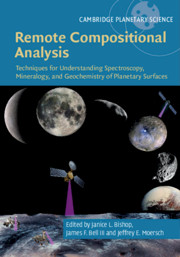 Remote Compositional Analysis
Remote Compositional Analysis from Part IV - Applications to Planetary Surfaces
Published online by Cambridge University Press: 15 November 2019
A Miniature Thermal Emission Spectrometer (Mini-TES), based on a Michelson interferometer and Cassegrain telescope, was carried by the Spirit rover in Gusev crater and Opportunity rover at Meridiani Planum to determine the bulk mineralogy of surface materials. Spectra from the plains of Gusev demonstrate the ubiquity of olivine-rich basaltic rocks, with additional examples lofted into the adjacent Columbia Hills by meteoroid impacts. Hundreds of rocks observed with mini-TES in the Columbia Hills display spectral characteristics of variable alteration intensity, but likely with very little water involved. Rare exceptions include a tephra deposit cemented by Mg–Fe carbonates and nodular opaline silica rocks, likely indicative of a hot spring/geyser environment. Opportunity’s mini-TES confirmed orbital identification of crystalline hematite at Meridiani Planum and spectral characteristics indicative of a transition from a precursor goethite phase. The sedimentary bedrock that hosts the hematite has spectral features consistent with Al-rich opaline silica, Mg-, Ca-, and Fe-bearing sulfates, plagioclase feldspar, and nontronite. Rare rocks at both sites are recognizable as iron meteorites from their infrared reflective properties.
To save this book to your Kindle, first ensure [email protected] is added to your Approved Personal Document E-mail List under your Personal Document Settings on the Manage Your Content and Devices page of your Amazon account. Then enter the ‘name’ part of your Kindle email address below. Find out more about saving to your Kindle.
Note you can select to save to either the @free.kindle.com or @kindle.com variations. ‘@free.kindle.com’ emails are free but can only be saved to your device when it is connected to wi-fi. ‘@kindle.com’ emails can be delivered even when you are not connected to wi-fi, but note that service fees apply.
Find out more about the Kindle Personal Document Service.
To save content items to your account, please confirm that you agree to abide by our usage policies. If this is the first time you use this feature, you will be asked to authorise Cambridge Core to connect with your account. Find out more about saving content to Dropbox.
To save content items to your account, please confirm that you agree to abide by our usage policies. If this is the first time you use this feature, you will be asked to authorise Cambridge Core to connect with your account. Find out more about saving content to Google Drive.